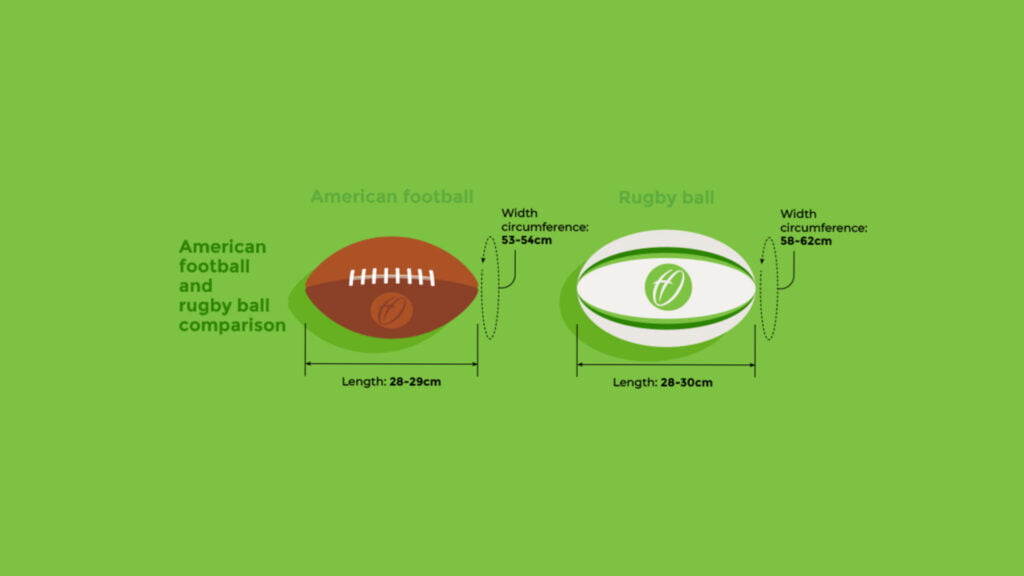If you’ve ever found yourself scratching your head, wondering whether you’re watching rugby or football, you’re not alone. From the shape of the ball to the rules of the game, rugby and football can seem like distant cousins of the same sporting family tree. Both are fast-paced, contact sports played with an oval-shaped ball, but beyond that, they have some key differences. In this guide, we’ll break down what sets these two sports (Rugby vs Football) apart so that the next time you’re at a game or watching one on TV, you’ll know exactly what’s going on.
The Shape of Things: Rugby and Football Balls
Let’s start with the most obvious difference: the ball. In rugby, the ball is typically larger and more rounded at the ends, allowing for easier handling during running plays and when passing. Footballs, on the other hand, have a more pointed shape, making them better suited for long, accurate throws down the field. The unique design of the football ball allows it to cut through the air with more precision. The rugby ball, while not as aerodynamic, is made to be gripped, passed, and kicked under intense physical pressure.
Despite their similarities, handling a rugby ball versus a American football requires a different skill set. Rugby players need to be able to control the ball through constant contact and short passes, while football players focus on throwing, catching, or kicking with pinpoint accuracy.
Rugby vs Football: The Rules of the Game
When it comes to rules, rugby and football are like night and day. One of the biggest differences is how the ball can be advanced. In football, the ball is primarily moved by passing it forward down the field or running it past defenders. Once a player is tackled, the play is over, and the offense has a chance to reset. In rugby, though, you can only pass the ball backward. That’s right—rugby players move the ball upfield by running forward and passing it back to their teammates. It adds an extra layer of strategy and makes for some exhilarating plays.
Rugby is a continuous flow sport. When a player is tackled, the ball remains in play unless it goes out of bounds or is ruled dead by the referee. There’s no stopping for huddles or play resets as you’d see in football. The players keep going, which can make rugby a more physically demanding sport since there are fewer breaks in the action.
Football, on the other hand, is more structured. You get four downs to move the ball 10 yards, and each play is carefully planned and executed. The stops between plays allow teams to regroup and make strategic decisions. Rugby teams must think on the fly, adapting to the fluidity of the game as it unfolds.
Scoring: Touchdowns vs. Tries
Scoring is another area where these two sports diverge. In football, players aim for touchdowns, worth six points, by getting the ball into the opposing team’s end zone. After a touchdown, teams have the option to kick an extra point or try for a two-point conversion.
Rugby players aim to score tries, which are worth five points, by touching the ball down in the opposing team’s in-goal area (the equivalent of the end zone in football). After scoring a try, the team can add two more points by kicking a conversion through the goalposts.
Kicking plays an important role in both sports, but rugby incorporates more frequent kicking options throughout the match. For example, teams can score three points by kicking a drop goal during live play or by converting a penalty kick if the opposing team commits a foul. Football’s kicking game, while crucial for field goals and extra points, is more restricted to specific situations like fourth downs or after a touchdown is scored.
Rugby vs Football:Number of Players and Positions
Another clear distinction between rugby and football is the number of players on the field. A football team has 11 players on the field at any given time, while rugby teams are comprised of 15 players. The extra bodies on the rugby field lead to a different style of gameplay. Rugby is more of a whole-team effort, as all players are expected to contribute both offensively and defensively. In football, the roles are more specialized, with players taking on specific offensive or defensive duties depending on their position.
Speaking of positions, the range of roles in each sport is distinct as well. In football, players are divided into offensive and defensive units. Each position is hyper-specialized: quarterbacks throw the ball, wide receivers catch it, and defensive linemen try to stop everything that moves. Rugby players, while they have specialized positions like forwards and backs, are more versatile. Forwards typically engage in the scrums and do the heavy lifting in rucks and mauls, while the backs are generally faster and more involved in open-field play.
In football, a kicker is often a dedicated position, only coming in for field goals or extra points. In rugby, kicking duties fall to regular players, usually the fly-half or full-back, who must also tackle, run, and pass throughout the game.
Rugby vs Football:Physical Contact and Tackling
Both sports are known for their heavy physical contact, but the way contact is regulated differs. Football players wear helmets and pads to protect themselves from the bone-crunching collisions that happen on nearly every play. Tackling in football can be incredibly violent, with players often launching themselves at opponents to bring them down.
Rugby players, however, wear minimal protective gear—usually just mouthguards and, sometimes, light padding. Tackling in rugby is governed by stricter rules. Players must wrap their arms around the opponent when tackling and can’t tackle above the shoulders. This leads to a different style of contact—rugby tackles are often lower and more controlled, while football tackles can be high-speed and forceful. Interestingly, despite the lack of pads, rugby players experience fewer serious head injuries than football players, as noted in this study. The reason lies partly in rugby’s tackling techniques, which emphasize safety and body control.
Rugby vs Football: Game Duration and Structure
Another significant difference between the two sports is the length and structure of the game. Football games are played in four 15-minute quarters, with stoppages of play extending the total duration to around three hours, depending on how the game unfolds. Timeouts, huddles, and commercial breaks all contribute to the length of a football game.
Rugby matches, on the other hand, are typically 80 minutes long, split into two 40-minute halves. The game clock rarely stops, and the pace remains steady throughout the match. If the ball goes out of play, the game continues with minimal delays. Because of this, rugby games tend to wrap up within a couple of hours.
Strategy and Play Styles
The strategic approaches in rugby and football are quite different, too. In football, strategy revolves around precise, pre-planned plays that involve careful positioning, timing, and execution. Teams spend hours practicing set plays for offense and defense, breaking down every aspect of the game to the finest details.
Rugby, while also highly strategic, relies more on adaptability and improvisation. Because rugby is a continuous flow sport, teams need to react to the changing dynamics of the game. While there are set pieces, like scrums and lineouts, much of rugby’s strategy is built on the fly. This difference leads to rugby games having a more unpredictable and dynamic nature compared to football, which can sometimes feel more methodical.
The Global Reach of Rugby and Football
When we think of football, we immediately associate it with the United States. It’s a national pastime, with the Super Bowl being one of the most-watched sporting events in the world. The NFL dominates the sport, with college football also drawing millions of viewers across the country. But outside of North America, football doesn’t have the same level of global presence.
Rugby, on the other hand, has a truly international footprint. Countries like New Zealand, Australia, South Africa, and England boast some of the strongest rugby traditions, with the Rugby World Cup being one of the biggest events in the sport. Rugby is also growing rapidly in countries like Japan and the United States, with more nations adopting the sport at both the amateur and professional levels. According to this research, rugby’s global appeal continues to expand as more nations embrace the sport’s unique blend of athleticism and teamwork.
Conclusion
Rugby and football might look similar at first glance, but once you dive deeper, it’s clear that they’re distinct sports with their own cultures, rules, and styles of play. Whether you prefer the fast-paced, continuous action of rugby or the tactical, hard-hitting nature of football, there’s something in both sports for everyone. And while you may still confuse them occasionally, understanding the differences will help you appreciate what each game has to offer.
Frequently Asked Questions
What are the main differences between rugby and football?
Rugby and football (soccer) differ in their rules, play style, scoring systems, and objectives. Rugby involves carrying and passing the ball by hand, while football focuses on controlling and kicking the ball. The physical contact in rugby is much more intense, with tackles and scrums being a regular part of the game, unlike football, which prohibits the use of hands (except for the goalkeeper) and emphasizes foot skills.
How do the rules of rugby differ from football?
In rugby, players can pass the ball backward or kick it forward, and the aim is to score a try or kick goals. Football restricts players to use only their feet to pass, shoot, and move the ball, and goals are the only scoring method. Rugby allows full-contact tackles, while football penalizes players for physical contact outside of fair challenges.
What is the scoring system in rugby vs. football?
In rugby, players score points through tries (5 points), conversions (2 points), penalty goals (3 points), and drop goals (3 points). In football, a goal is worth 1 point, and the team with the most goals at the end of the game wins.
How do the positions in rugby compare to those in football?
Rugby positions are divided into forwards and backs, with specific roles such as props, locks, and fly-halves, focusing on scrums, lineouts, and attacking plays. Football has defenders, midfielders, forwards, and a goalkeeper, each with distinct responsibilities around ball control, defense, and scoring.
What equipment is used in rugby that differs from football?
Rugby players wear jerseys, shorts, cleats, mouthguards, and sometimes headgear. The ball used in rugby is oval-shaped, unlike the spherical ball used in football. Football players use shin guards, and goalkeepers wear gloves. Protective gear in rugby tends to be minimal despite the rough nature of the game.
Are there differences in the physical demands of rugby and football?
Yes, rugby requires intense physicality with constant tackles, scrums, and rucks, demanding strength and endurance. Football requires more agility, speed, and stamina for continuous running, with fewer direct physical confrontations compared to rugby.
How does the field size and layout vary between rugby and football?
A rugby field is typically larger, around 100 meters in length and 70 meters in width, with H-shaped goalposts at each end. A football field is usually between 100-110 meters long and 64-75 meters wide, with rectangular goals at each end.
What are the origins of rugby and football?
Rugby originated in England in the 19th century, reportedly after a player picked up the ball during a football match at Rugby School. Football, or soccer, also has roots in England and developed from a variety of kicking games played throughout Europe over centuries, formalized in the 1860s with the creation of the Football Association.
How does tackling differ between rugby and football?
Tackling in rugby is a legal and essential part of the game, allowing players to bring opponents to the ground to stop progress. In football, tackling involves trying to win the ball by making contact with the ball rather than the player, and physical tackles are penalized.
What are the differences in game duration for rugby vs football?
Rugby matches last 80 minutes, split into two halves of 40 minutes each. Football matches are 90 minutes long, also divided into two halves of 45 minutes, with stoppage time added for injuries or delays.
Which is more popular globally: rugby or football?
Football (soccer) is more popular globally, with a fanbase of over 4 billion people. Rugby has a significant following, especially in countries like England, New Zealand, Australia, and South Africa, but its global reach is more limited compared to football.
Do rugby and football have different levels of player protection?
Yes, rugby players wear minimal protection, mainly mouthguards and optional headgear, despite the high-contact nature of the sport. Football players, especially goalkeepers, use shin guards and gloves, and the rules protect against heavy physical contact.
How does the flow of play differ between rugby and football?
Rugby has more frequent stops and set pieces, such as scrums and lineouts, but the action can also be continuous when teams are passing and running. Football tends to have a more continuous flow, with breaks only for fouls, free kicks, or substitutions.
What is the difference between rugby union and rugby league, and how does that compare to football?
Rugby union and rugby league are two variants of rugby with differences in rules and play style. Rugby union has 15 players per team and emphasizes scrums and lineouts, while rugby league has 13 players and focuses on continuous play without set pieces. Football is a single unified sport without such divisions, though there are variations like futsal or beach soccer.
Can someone easily transition from football to rugby, or vice versa?
Transitioning from football to rugby, or vice versa, can be challenging because the sports demand different skill sets. Football players need agility, precision in ball control, and a high level of endurance. Rugby players need strength, physical toughness, and tackling skills. While both require stamina, the nature of gameplay and contact is very different.



